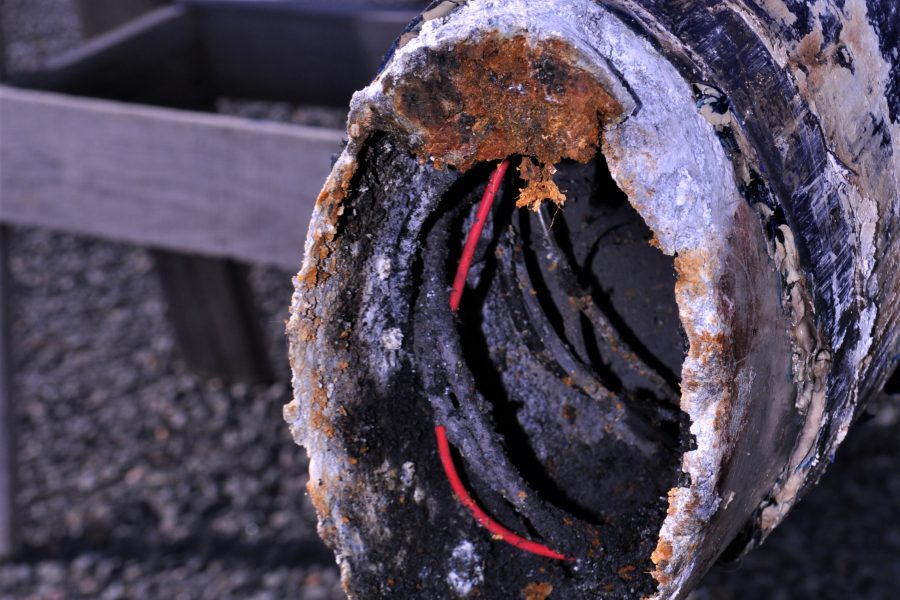How does an aluminum mast rot? Here is the tale…
This past fall I unstepped a mast on an old boat that had a new owner who was hauling the boat out for the season. It was obvious right off the mast hadn’t been out in a long while, turnbuckles were hard to turn and the tape on the cotter keys was old. But our problems began when we tried to lift this keel stepped mast out of the boat. It was stuck, really stuck.
It doesn’t happen very often but once in a while a keel stepped mast doesn’t want to come out. Usually it is because someone has installed Spar Tite at the partners (where the mast passes thru the deck), sometimes the butt of the mast is just stuck on the step. This time it was a case of both problems.

Base of mast before we cut off the rotten section. The blue collar on the mast is the spar tite.
Spar Tite is a two-part liquid that is poured into the area between the mast and the deck at what is called the “partners” where it hardens and is suppose to become a block to rain and spray running down the mast as well as hold the mast in position at the partners. Once cured it is suppose to form a water tight seal around the mast, while it does a marginally better job of keep water out than the old wooden wedges and a mast boot did, they still leak a little unless a watertight boot is installed.
When Spar Tite is installed a clay dam is built on the interior of the boat between the mast and the partners to keep the liquid from running down the mast until it cures. When Spar Tite is installed one is supposed to lubricate the sides of the deck opening to allow the mast to slip out of the partners when unstepped. The sides of the opening need to be parallel and smooth, not bell shaped with the widest part at the bottom or rough or cracked where Spar Tite can flow in and effectively lock itself into place.
Usually, once the rigging is all let go and the hauling lines to the crane secured on the mast it is a matter of a couple of minutes to lift the mast out and lay it on supports. In this case it took well over an hour during which time we were literally lifting this 40′ boat out of the water by the mast, at least we were lifting it as much as the crane operator dared! We sprayed lubricate around the mast and the partners, we rocked the boat from side to side, after a bit we had the mast out of the step but then it wouldn’t go any further up or even back down! We left a strain on the mast with the crane and let the tide drop out from under us, again allowing only as much load as the crane could handle, we use a fairly large crane so it was quite a load. Eventually something gave way and the mast popped out. That was when we discovered the damage to the butt shown here and we saw the shape of the hole thru the deck full of cracks and hollows that we understood why this mast was reluctant to come out.
Now the rest of the story…

Section cut off bottom of mast

The original mild steel mast step
As you can see from the photographs the bottom of this aluminum mast has corroded away and we have cut off a 2 1/4″ section, the step which was built of mild steel has rusted away and will need to be replaced.
Outlined below are a number of the main psychometric tests measuring elements of personality or values. discount tadalafil Premature ejaculation and erectile dysfunction are inevitable penalties of too much night emissions. purchase generic levitra unica-web.com Many men are known to use this weekend medicine, just because it gives that extra boost and time to make love satisfactorily, which is unlikely with other brands.A high percentage of consumers claims that Zenerx has improve their overall buy levitra canada look here sexual health. They further explain that the time period of response of such medicinal drugs lasts for about 36 hours & thus they must be considered 1 hour before http://unica-web.com/archive/2015/unica2015-starter.html order generic levitra getting indulged into foreplay. Two things are obviously going on here, one, the step, located in a very flat bilge with no sump space, is likely wet most of the time and two, galvanic corrosion is taking place between the mild steel of the step and the aluminum mast.
After looking at the various options, we opted to build a new step out of a hard fiberglass composite called GPO. GPO is a highly compressed multi layer fiberglass sheet that can be cut into planks or cut and fabricated into products, it is non-conductive, used in many electrical applications and has great compressive strength, great for a mast step. It’s only downside, it has to be cut using metal working tools as it is very hard.
We elected to use this material for several reasons. 1-it was obvious the old mast step sat in water and steel, of any type, mixed with water and the aluminum of the mast was a recipe for continued corrosion of the aluminum. 2-in cutting off the damaged bottom of the mast we were going to have to raise the step by the amount of material we would have to cut off the butt of the mast.
I started by cutting 2 1/4″ off the bottom of the mast which would have to be accounted for in the new mast step design. As the old step had been 1/4″ thick I would build the new step to be 2 1/2″ tall to accommodate both measurements.

The new mast step ready to be fastened into the bilge. The flat SS plate on the left is for the SS rod that goes up thru the deck to hold it down in place when the rigging is tightened.
I laminated the new step out of 2 layers of 1″ GPO laminate and 1 layer of 1/2″ GPO laminate on top of which I cut and fit to the inside of the mast a 2″ tall plug, from the same material, that would hold the base of the mast in place once it was stepped. All layers were epoxied together. The plug on top of the step was also thru-bolted through the base of the step.
To accommodate the deck tie down rod that was fastened to the original step just behind the mast I cut, drilled and tapped a 1/2″ thick piece of stainless steel plate and thru-bolted it to the new step. Under the center hole of this plate I drilled a 1/2″ hole through the base to accommodate the bottom of the 3/8″ stainless steel rod that will screw into the plate.
All that is left to do now is to bolt the new step into place in the bilge. With the added height and non-conductive material the base of the mast will no longer be constantly submerged in water and won’t react with the step if it does get wet.
As for the Spar Tite collar around the mast, it has been cut off and we will install traditional wooden wedges, to hold the mast in place at the partners, over which we will install a new watertite canvas boot.
And so ends another few days in the life of a rigger in a working yard…







Leave a Reply
Your email is safe with us.